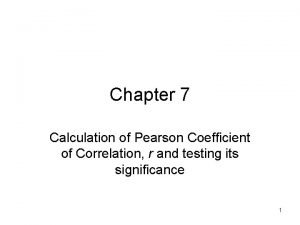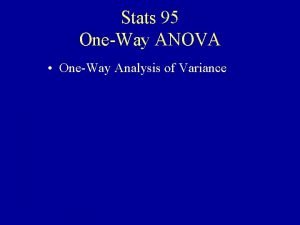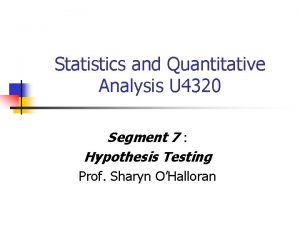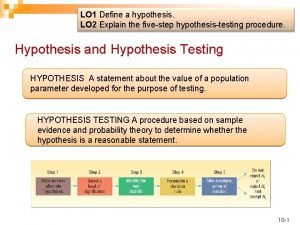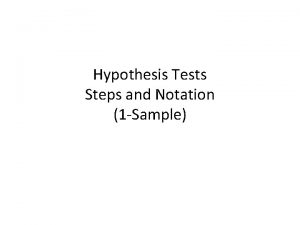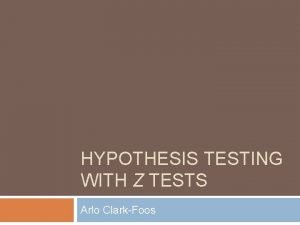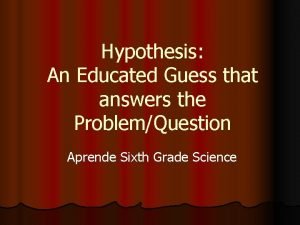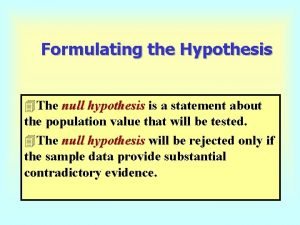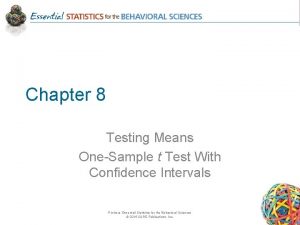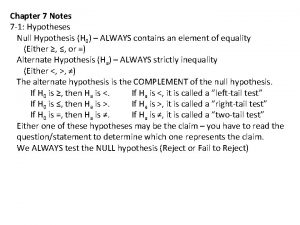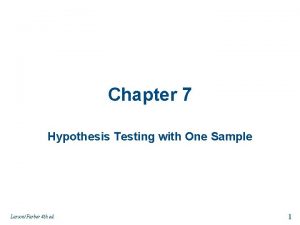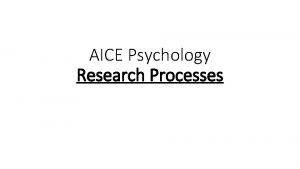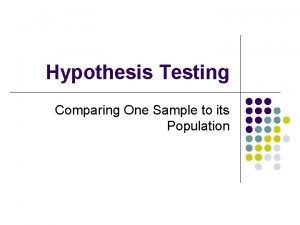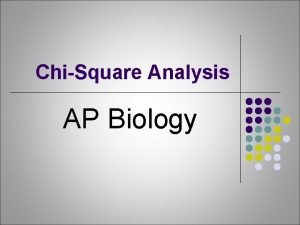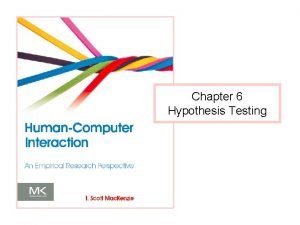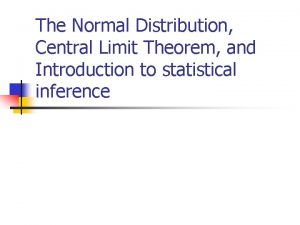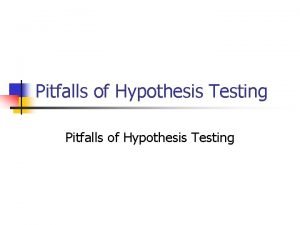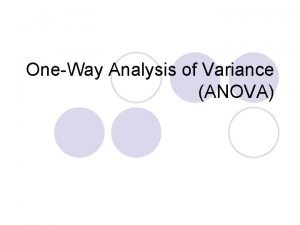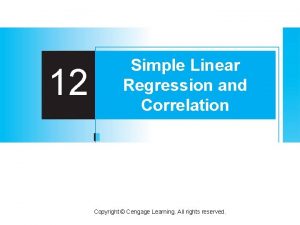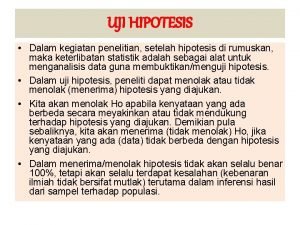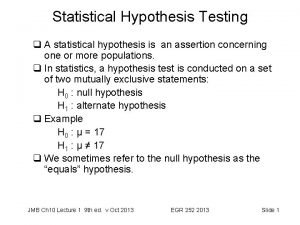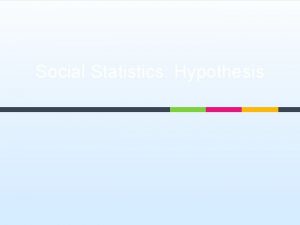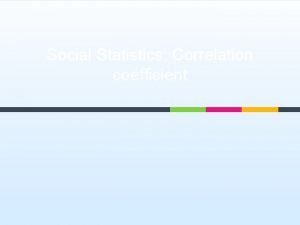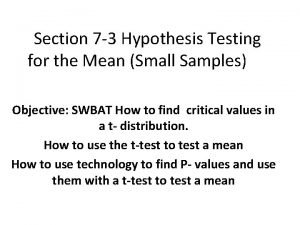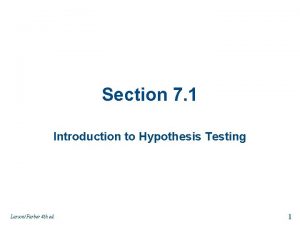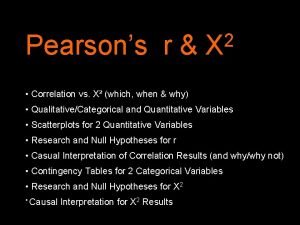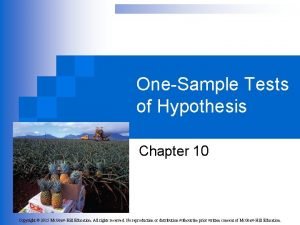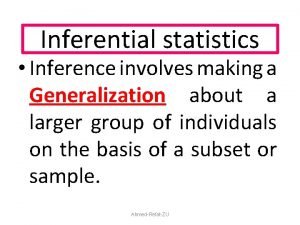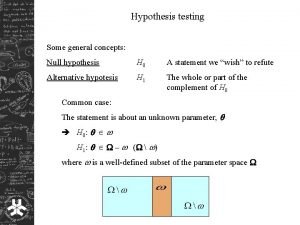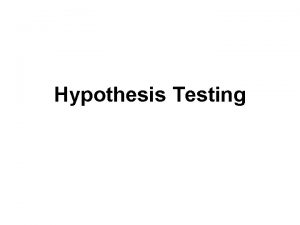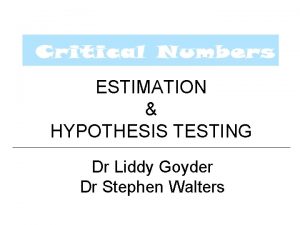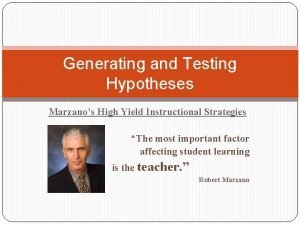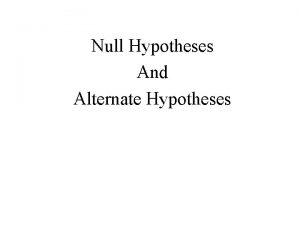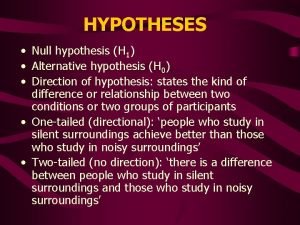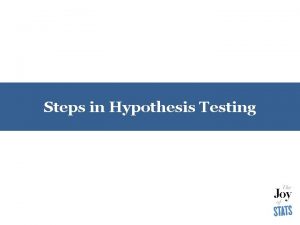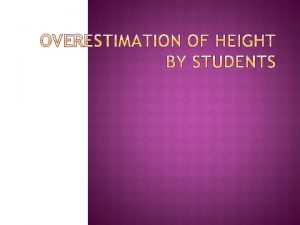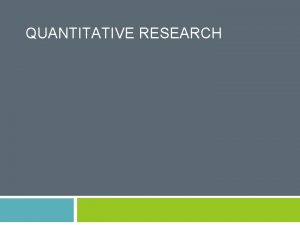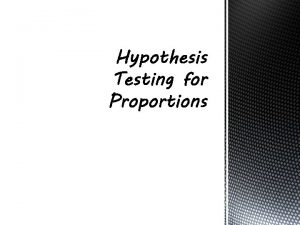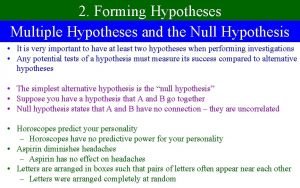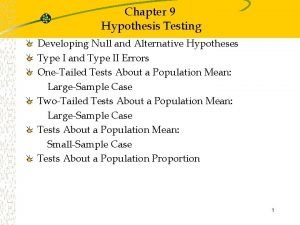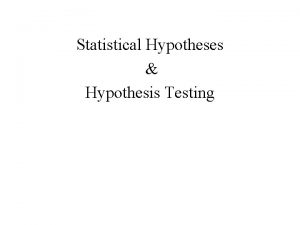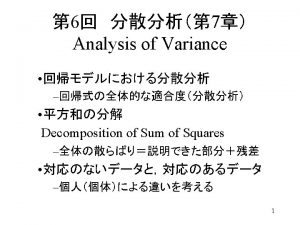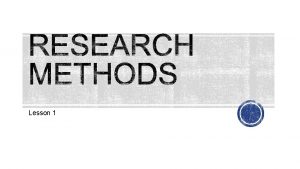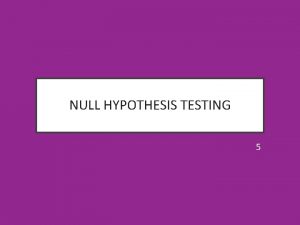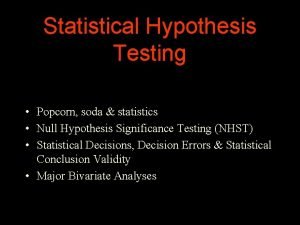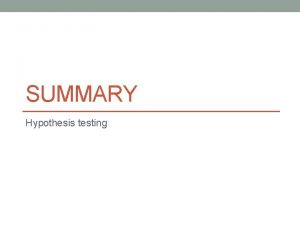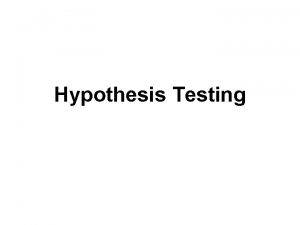Developing Null and Alternative Hypotheses 4 l Hypothesis







































- Slides: 39




Developing Null and Alternative Hypotheses 4 l Hypothesis testing can be used to determine whether a statement about the value of a population parameter should or should not be rejected. l The null hypothesis, denoted by H 0 , is a tentative assumption about a population parameter. l The alternative hypothesis, denoted by H 1, is the opposite of what is stated in the null hypothesis. l Hypothesis testing is similar to a criminal trial. The hypotheses are: H 0: The defendant is innocent H 1: The defendant is guilty Jia-Ying Chen

A Summary of Forms for Null and Alternative Hypotheses about a Population Mean The equality part of the hypotheses always appears in the null hypothesis. l In general, a hypothesis test about the value of a population mean must take one of the following three forms (where 0 is the hypothesized value of the population mean). H 0: = 0 H 1: < 0 H 1: > 0 H 1: 0 l 5 Jia-Ying Chen

Concepts of Hypothesis Testing l The critical concepts of hypothesis testing. l Example: l An operation manager needs to determine if the mean demand during lead time is greater than 350. l If so, changes in the ordering policy are needed. l There are two hypotheses about a population mean: l H 0: The null hypothesis μ = 350 l H 1: The alternative hypothesis μ > 350 ove 6 ou his ty a h w is to want pr Jia-Ying Chen

Example 1 l 7 A spouse suspects that the average amount of money spent on Christmas gifts for immediate family members is above $1, 200. The correct set of hypotheses is: a. H 0: μ = 1200 vs. H 1: μ < 1200 b. H 0: μ > 1200 vs. H 1: μ = 1200 c. H 0: μ = 1200 vs. H 1: μ > 1200 d. H 0: μ < 1200 vs. H 1: μ = 1200 Jia-Ying Chen

Concepts of Hypothesis Testing l Assume the null hypothesis is true (m= 350). m = 350 l l 8 Sample from the demand population, and build a statistic related to the parameter hypothesized (the sample mean). Pose the question: How probable is it to obtain a sample mean at least as extreme as the one observed from the sample, if H 0 is correct? Jia-Ying Chen

Concepts of Hypothesis Testing l Assume the null hypothesis is true (m= 350). m = 350 l l 9 Since the is much larger than 350, the mean m is likely to be greater than 350. Reject the null hypothesis. In this case the mean m is not likely to be greater than 350. Do not reject the null hypothesis. Jia-Ying Chen

Types of Errors l l 10 Two types of errors may occur when deciding whether to reject H 0 based on the statistic value. l Type I error: Reject H 0 when it is true. l Type II error: Do not reject H 0 when it is false. Example continued l Type I error: Reject H 0 (m = 350) in favor of H 1 (m > 350) when the real value of m is 350. l Type II error: Believe that H 0 is correct (m = 350) when the real value of m is greater than 350. Jia-Ying Chen

Type I and Type II Errors l l 11 Since hypothesis tests are based on sample data, we must allow for the possibility of errors. The person conducting the hypothesis test specifies the maximum allowable probability of making a Type I error, denoted by and called the level of significance. Generally, we cannot control for the probability of making a Type II error, denoted by . Statistician avoids the risk of making a Type II error by using “do not reject H 0” and not “accept H 0”. Jia-Ying Chen

Decision Table for Hypothesis Testing 12 Null True Null False Fail to reject null Correct Decision Type II error ( ) Reject null Type I error ( ) Correct Decision (Power) Jia-Ying Chen

Controlling the probability of conducting a type I error l Recall: l l H 0: m = 350 and H 1: m > 350. H 0 is rejected if is sufficiently large Thus, a type I error is made if when m = 350. By properly selecting the critical value we can limit the probability of conducting a type I error to an acceptable level. Critical value 13 m = 350 Jia-Ying Chen

Steps in Hypothesis Testing 1. Establish hypotheses: state the null and alternative hypotheses. 2. Determine the appropriate statistical test and sampling distribution. 3. Specify the Type I error rate ( 4. State the decision rule. 5. Gather sample data. 6. Calculate the value of the test statistic. 7. State the statistical conclusion. 8. Make a managerial decision. 14 Jia-Ying Chen

Testing the Population Mean When the Population Standard Deviation is Known l Example l l l 15 A new billing system for a department store will be cost- effective only if the mean monthly account is more than $170. A sample of 400 accounts has a mean of $178. If accounts are approximately normally distributed with s = $65, can we conclude that the new system will be cost effective? Jia-Ying Chen

Testing the Population Mean (s is Known) l Example 11. 1 – Solution l l The population of interest is the credit accounts at the store. We want to know whether the mean account for all customers is greater than $170. H 1 : m > 170 l 16 The null hypothesis must specify a single value of the parameter m, H 0 : m = 170 Jia-Ying Chen

Approaches to Testing l There are two approaches to test whether the sample mean supports the alternative hypothesis (H 1) l l 17 The rejection region method is mandatory for manual testing (but can be used when testing is supported by a statistical software) The p-value method which is mostly used when a statistical software is available. Jia-Ying Chen

The Rejection Region Method The rejection region is a range of values such that if the test statistic falls into that range, the null hypothesis is rejected in favor of the alternative hypothesis. 18 Jia-Ying Chen

The Rejection Region Method for a Right - Tail Test Example 11. 1 – solution continued • Define a critical value for to reject the null hypothesis. that is just large enou • Reject the null hypothesis if 19 Jia-Ying Chen

Determining the Critical Value for the Rejection Region l l 20 Allow the probability of committing a Type I error be (also called the significance level). Find the value of the sample mean that is just large enough so that the actual probability of committing a Type I error does not exceed Watch… Jia-Ying Chen

Determining the Critical Value – for a Right – Tail Test Example – solution continued P(commit a Type I error) = P(reject H 0 given that H 0 is tru = P( true) 21 given that H 0 is… is allowed to be we have: Jia-Ying Chen

Determining the Critical Value – for a Right – Tail Test Example – solution continued = 0. 05 22 Jia-Ying Chen

Determining the Critical value for a Right - Tail Test Conclusion 23 Since the sample mean (178) is greater than the critical value of 175. 34, there is sufficient evidence to infer that the mean monthly balance is greater than $170 at the 5% significance level. Jia-Ying Chen

The standardized test statistic l Instead of using the statistic the standardized value z. , we can use l Then, the rejection region becomes One tail test 24 Jia-Ying Chen

The standardized test statistic l Example - continued l We redo this example using the standardized test statistic. Recall: H 0: m = 170 H 1: m > 170 Test statistic: l Rejection region: z > z. 05 = 1. 645. l 25 Jia-Ying Chen

The standardized test statistic l Example - continued Conclusion Since Z = 2. 46 > 1. 645, reject the null hypothesis in favor of the alternative hypothesis. 26 Jia-Ying Chen

P-value Method l The p-value provides information about the amount of statistical evidence that supports the alternative hypothesis. – The p-value of a test is the probability of observin test statistic at least as extreme as the one comp given that the null hypothesis is true. –虛無假設成立,獲得檢定統計量及更極端數值之機率。 –Let us demonstrate the concept on Example 27 Jia-Ying Chen

P-value Method The probability of observing a test statistic at least as extreme as 178, given that m = 170 is… 28 The p-value Jia-Ying Chen

Interpreting the p-value Because the probability that the sample mean will assume a value of more than 178 when m = 170 is so small (. 0069), there are reasons to believe that m > 170. Note how the event is rare under H 0 when but. . . …it becomes more probable under H 1, when 29 Jia-Ying Chen

Interpreting the p-value We can conclude that the smaller the pvalue the more statistical evidence exists to support the alternative hypothesis. 30 Jia-Ying Chen

The p-value and the Rejection Region Methods l The p-value can be used when making decisions based on rejection region methods as follows: Define the hypotheses to test, and the required significance level α. l Perform the sampling procedure, calculate the test statistic and the p-value associated with it. l Compare the p-value to α. Reject the null hypothesis only if p-value < α; otherwise, do not reject the null hypothesis. l = 0. 05 The p-value 31 Jia-Ying Chen

Conclusions of a Test of Hypothesis 32 l If we reject the null hypothesis, we conclude that there is enough evidence to infer that the alternative hypothesis is true. l If we do not reject the null hypothesis, we conclude that there is not enough statistical evidence to infer that the alternative hypothesis is true. The alternative hypothesi is the more important one. It represents what we are investigating. Jia-Ying Chen

Example 2 l 33 If a hypothesis is not rejected at the 0. 10 level of significance, it: a. must be rejected at the 0. 05 level. b. may be rejected at the 0. 05 level. c. will not be rejected at the 0. 05 level. d. must be rejected at the 0. 025 level. Jia-Ying Chen

Example 3 l 34 Calculate the value of the test statistic, set up the rejection region, determine the p-value, interpret the result, and draw the sampling distribution. Jia-Ying Chen

Solution l 35 Rejection region z<z 0. 1=-1. 28 Jia-Ying Chen

Example 4 l A business student claims that on average an MBA students is required to prepare more than five cases per week. To examine the claim, a statistics professor asks a random sample of 10 MBA students to report the number of cases they prepare weekly. The results are exhibited here. Can the professor conclude at the 5% significance level that the claim is true, assuming that the number of cases is normally distributed with a standard deviation of 1. 5? 2 7 4 8 9 5 11 3 7 4 36 Jia-Ying Chen

Solution 37 Jia-Ying Chen

Example 5 l A random sample of 12 second-year university students enrolled in a business statistics course was drawn. At the course’s completion, each student was asked how many hours he or she spent doing homework in statistics. The data are listed here. It is known that the population standard deviation is σ=8. The instructor has recommended that students devote 3 hours per week for the duration of the 12 -week semester, for a total of 36 hours. Test to determine whethere is evidence that the average student spent less than the recommend amount of time. Compute the p-value of the test. 31 40 26 30 36 38 29 40 38 30 35 38 38 Jia-Ying Chen

Solution 39 Jia-Ying Chen
 Developing null and alternative hypothesis
Developing null and alternative hypothesis Site:slidetodoc.com
Site:slidetodoc.com Ssyy formula
Ssyy formula What is a hypothesis
What is a hypothesis One way anova null hypothesis
One way anova null hypothesis When to reject null hypothesis critical value
When to reject null hypothesis critical value What is a directional hypothesis in psychology
What is a directional hypothesis in psychology Hypothesis for two way anova
Hypothesis for two way anova Standard deviation null hypothesis
Standard deviation null hypothesis Hypothesis
Hypothesis Null hypothesis assumptions
Null hypothesis assumptions Is a hypothesis an educated guess
Is a hypothesis an educated guess Example of null hypothesis
Example of null hypothesis What is chi square used for
What is chi square used for Effect size for t-test
Effect size for t-test Examples of null hypothesis
Examples of null hypothesis P-value two tailed test
P-value two tailed test What is aice psychology
What is aice psychology Test stat formula
Test stat formula Chi square ap biology
Chi square ap biology Mann whitney null hypothesis
Mann whitney null hypothesis What is harmful dysfunction
What is harmful dysfunction Central limit theorem standard error
Central limit theorem standard error Steps in hypothesis testing ppt
Steps in hypothesis testing ppt How to report anova results
How to report anova results Simple regression hypothesis
Simple regression hypothesis Contoh ho dan ha
Contoh ho dan ha Null hypothesis example
Null hypothesis example Null hypothesis
Null hypothesis T-test for correlation
T-test for correlation Testing of hypothesis
Testing of hypothesis Alternatuve hypothesis
Alternatuve hypothesis Pearson's r
Pearson's r Hypothesis format
Hypothesis format Null hypothesis
Null hypothesis What is null hypothesis
What is null hypothesis Alternative hypothesis
Alternative hypothesis Null hypothesis example
Null hypothesis example Marketing channel structures
Marketing channel structures Marzano high yield strategies
Marzano high yield strategies


